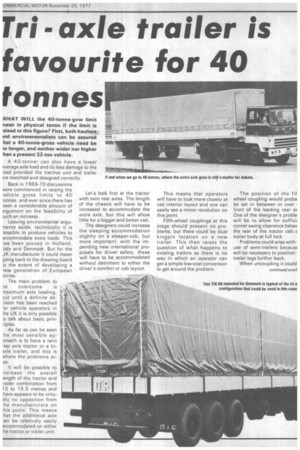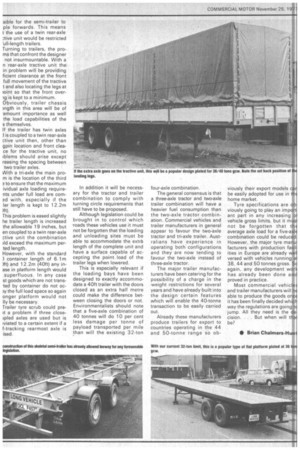Fri-axle trailer is
Page 57

Page 58

If you've noticed an error in this article please click here to report it so we can fix it.
favourite for 40
tonnes
NHAT WILL the 40-tonne-gvw limit nean in physical terms if the limit is .aised to this figure? First, both hauliers Ind environmentalists can be assured hat a 40-tonne-gross vehicle need be to longer, and neither wider nor higher han a present 32-ton vehicle.
A 40-tonner can also have a lower iverage axle load and do less damage to the • oad provided the tractive unit and trailer ire matched and designed correctly.
Back in 1969-70 discussions were commenced in raising the /ehicle gross limits to 40 onnes, and ever since there has peen a considerable amount of irgument on the feasibility of wch an increase.
Leaving environmental argu-nents aside, technically it is possible to produce vehicles to iccommodate extra loads. This las been proved in Holland, taly and Denmark. But for the JK manufacturer it could mean joing back to the drawing board .o the extent of developing a iew generation of European orries.
The main problem to
D e overcome is -naximum axle loading, Jut until a definite de:ision has been reached or vehicle operators in :he UK it is only possible :o talk about basic prin:.iples.
As far as can be seen :he most sensible approach is to have a twin 'ear axle tractor or a triaxle trailer, and this is where the problems arse.
It will be possible to ncrease the overall ength of the tractor and 'railer combination from 15 to 15.5 metres and 'here appears to be virtuilly no opposition from :he manufacturers on his point. This means :hat the additional axle an be relatively easily Iccommodated on either he tractor or trailer unit. Let's look first at the tractor with twin rear axles. The length of the chassis will have to be increased to accommodate the extra axle, but this will allow little for a bigger and better cab.
The designers could increase the sleeping accommodation slightly on a sleeper-cab, but more important, with the impending new international proposals for driver safety, these will have to be accommodated without detriment to either the driver's comfort or cab layout. This means that operators will have to look more closely at cab interior layout and one can easily see a minor revolution on this point.
Fifth-wheel couplings at this stage should present no problems, but there could be dual kingpin location on a new trailer. This then raises the question of what happens to existing trailers as there is no way in which an operator can get a simple low-cost conversion to get around the problem. The position of the fif wheel coupling would proba be set in between or over • front of the leading rear a> One of the designer's proble will be to allow for suffice' corner swing clearance betwE the rear of the tractor cab z• trailer body at full lock.
Problems could arise with • use of semi-trailers becausE will be necessary to position • trailer legs further back.
When uncoupling it could
sible for the semi-trailer to pie forwards. This means t the use of a twin rear-axle .7-dye unit would be restricted 'ull-length trailers.
Turning to trailers, the proms that confront the designer not insurmountable. With a n rear-axle tractive unit the in problem will be providing ficient clearance at the front full movement of the tractive t and also locating the legs at /oint so that the front over1g is kept to a minimum.
Obviously, trailer chassis ?.ngth in this area will be of .amount importance as well the load capabilities of the s themselves.
If the trailer has twin axles 1 is coupled to a twin rear-axle 7.tive unit then, other than gpin location and front cleace for the tractive unit, no iblems should arise except reasing the spacing between two trailer axles.
With a tri-axle the main prom is the location of the third a to ensure that the maximum ividual axle loading requirents under full load are corned with, especially if the ler length is kept to 12.2m /ft).
This problem is eased slightly he trailer length is increased the allowable 19 inches, but en coupled to a twin rear-axle :five unit the combination dd exceed the maximum perted length.
However, with the standard ) container length of 6.1m /ft) and 12.2m (40ft) any inase in platform length Would superfluous. In any case St goods which are not transled by container do not oc)y the full load space so again onger platform would not Ily be necessary.
Trailer tyre scrub could preit a problem if three closeipled axles are used but is iviated to a certain extent if a f-tracking rearmost axle is ised. In addition it will be necessary for the tractor and trailer combination to comply with turning circle requirements that still have to be proposed.
Although legislation could be brought in to control which 'roads these vehicles use it must not be forgotten that the loading and unloading sites must be able to accommodate the extra length of the complete unit and have a surface capable of accepting the point load of the trailer legs when lowered.
This is especially relevant if the loading bays have been designed to exactly accommodate a 40ft trailer with the doors closed as an extra half metre could make the difference between closing the doors or not. Environmentalists should note that a five-axle combination of 40 tonnes will do 10 per cent less damage per tonne of payload transported per mile than will the existing 32-ton four-axle combination.
The general consensus is that a three-axle tractor and two-axle trailer combination will have a heavier fuel consumption than the two-axle tractor combination. Commercial vehicles and trailer manufacturers in general appear to favour the two-axle tractor and tri-axle trailer. Australians have experience in operating both configurations and they are now tending to favour the two-axle instead of three-axle tractor.
The major trailer manufacturers have been catering for the possibility of a charge in the weight restrictions for several years and have already built into the design certain features which will enable the 40-tonne transaction to be easily carried out.
Already these manufacturers produce trailers for export to countries operating in the 44 and 50-tonne range so ob
viously their export models car be easily adopted for use in thE home market.
Tyre specifications are obviously going to play an important part in any increasing 61 vehicle gross limits, but it mu0 not be forgotten that thE average axle load for a five-al combination could be reduced!. However, the major tyre mar*, facturers with production faclil, ities in Europe are already w401 versed with vehicles running 01 38, 44 and 50 tonnes gross. Se .again, any development work has already been done arid proved in practice.
Most commercial vehic10 and trailer manufacturers will114 able to produce the goods onCe it has been finally decided whiOh way the regulations are going tá jump. All they need is the 4
cision. . . But when will thiE0 be?
• Brian Chalmers-Hu t










































































































